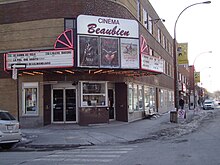Cinema of Quebec
| Cinema of Quebec | |
|---|---|

|
|
| No. of screens | 752 (2012) |
| Number of admissions (2012) | |
| Total | 21,093,030 |
| National films | 1,229,964 (5.8%) |
| Gross box office (2011) | |
| Total | $192 million |
The history of cinema in Quebec started on June 27, 1896 when the Frenchman Louis Minier inaugurated the first movie projection in North America in a Montreal theatre room. However, it would have to wait until the 1960s before a genuine Quebec cinema industry would emerge. Approximately 620 feature-length films have been produced, or partially produced by the Quebec film industry since 1943.
Due to language and cultural differences between the predominantly francophone population of Quebec and the predominantly anglophone population of the rest of Canada, Quebec's film industry is commonly regarded as a distinct entity from its English Canadian counterpart. In addition to participating in Canada's national Genie Awards, the Quebec film industry also maintains its own awards ceremony, the Jutra Awards. In addition, the popularity of homegrown French language films among Quebec audiences, as opposed to English Canadians' preference for Hollywood films, means that Quebec films are often more successful at the box office than English Canadian films — in fact, the top-grossing Canadian film of the year is often a French language film from Quebec.
From 1896 to the 1960s, the Catholic clergy tried to control what movies Quebecers could see. Two methods were employed: censorship and prohibition of attendance by children under 16. In 1913, the Bureau de censure de vues animées (Office of censorship for motion pictures) began regulating the projection of movies in Quebec. In 1927, the Laurier-Palace theatre burned down, killing many children. The church then almost succeeded at closing down all projection rooms in the province. However, the Parliament of Quebec passed a law preventing only children under 16 from attending movie projections. This law would be repealed only in 1961.
Nevertheless, some films were produced in Quebec during this period. Those were mostly documentaries, some of which were made by priests (Albert Tessier) and civil servants (Herménégilde Lavoie). In the 1940s and 1950s, the first commercial attempts at cinema happened. Two production houses were at the origins of all the movies of this period: Renaissance Films and Québec Productions. Most of the commercial feature films came primarily from four directors: Fyodor Otsep, Paul Gury, Jean-Yves Bigras, and René Delacroix. Notable films of this period include Le père Chopin (1945), Un homme et son péché (1949), La petite Aurore l'enfant martyre (1952), Tit Coq (1953), and Les brûlés (1959).
...
Wikipedia
